Scuba Diver Shakes Hands with a Giant Pacific Octopus
Port Hardy, Vancouver Island British Columbia is home to this incredible Giant Pacific octopus seen in the video. Port Hardy is a district municipality in British Columbia, Canada located on the northeastern end of Vancouver Island with a population of approximately 4,132. It is the gateway to Cape Scott Provincial Park, the North Coast Trail and the BC Marine Trail, located on the northernmost tip of Vancouver Island. The community has access to spectacular wilderness adventures, such as kayaking, caving, world-class scuba diving, nature viewing, surfing, unique saltwater rapids, fishing and camping. To make your way to this incredible location from the Greater Vancouver area, you must take B.C. Ferries to either the cities of Victoria on the southern tip of Vancouver Island or Nanaimo, which is located approximately one third way up the Island toward Port Hardy. From these locations you must drive or if really adventurous, sea plane transportation is also available. Driving from Victoria the distance is 502 kilometres (312 miles), Nanaimo 352 kilometres (218 miles) but is a very beautiful way to see the incredible scenery Vancouver Island has to offer. For scuba divers, the area all around Vancouver Island offers some incredible dive locations with pristine clear waters and abundance of life. The Giant Pacific octopus such as the one seen here are extremely intelligent and curious creatures. They have a relatively short life span of 3 to 5 years but grow to an amazing size ranging from 10 to 16 feet and weighing from 10 kilograms (22 pounds) to 50 kilograms (110 pounds) making them the size of an average 6 foot man. As mentioned they live to be about four years old, with both males and females dying soon after breeding. Females live long enough to tend fastidiously to their eggs, but they do not eat during this months-long brooding period, and usually die soon afterwards. As you may know, like the other members of the octopus family, these amazing animals use special pigment cells in their skin to change colors and textures, and can blend in with even the most intricately patterned corals, plants, and rocks much as we see this one blending with the rocky wall and kelp. Along with the octopus we see, there are also plumose anemone within view. These common anemones are easily recognized by their abundant, much-branched tentacles, enough of them to create a feathery (plumose) effect. Anemones are predators within the ocean and take just about anything that floats by, including small fish, but most of their prey is not much larger than microscopic. They bear two types of tentacles which they use for catching food, the common ones used for feeding and much less common ones used for defense. The latter can be extended to 3-4x their resting length while “searching” the water around them. If they encounter another species of anemone or a different genetic clone of the same species, the tip breaks off and adheres to the other individual, killing cells at that spot and possibly the entire animal. Divers all over the world find each and every animal they encounter , no matter it’s size, simply amazing to be within it’s domain. The colors, and activity of all of ocean life seems to amaze mankind without a doubt and becoming a scuba diver is a dream of many and easily attained for almost anyone from children to the more mature in age. Interacting with these creatures should only be done by those with extreme experience and knowledge of the animal’s characteristics. As divers often say “take only photos and leave only bubbles!” Let’s all do our part to keep our oceans clean so we can enjoy it’s life for centuries to come.
-
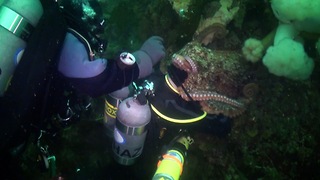 3:16
3:16
cdngreenwaterdiver
6 years ago $389.65 earnedGiant Pacific Octopus Sucks Up Scuba Diver
541K17 -
 1:56
1:56
fel_gomez
6 years agoScuba Diver Lends A Playing Hand To Curious Tiny Octopus
608K1 -
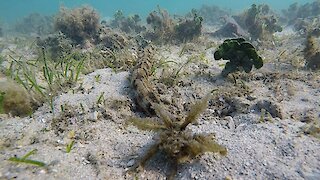 1:30
1:30
WildCreatures
4 years ago $12.93 earnedScuba diver encounters incredibly bizarre underwater animal
57.9K2 -
 1:02
1:02
cdngreenwaterdiver
5 years ago $6.18 earnedCurious octopus closely inspects scuba diver
23.9K6 -
 1:32
1:32
WildCreatures
2 years ago $136.61 earnedScuba diver has close encounter with ocean's top predator
19.3K46 -
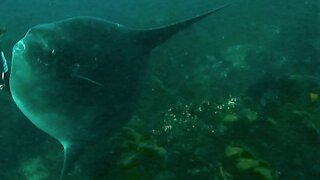 0:49
0:49
KristysWorld
2 years ago $32.54 earnedScuba divers meet one of the world's most bizarre gigantic fish
4.11K26 -
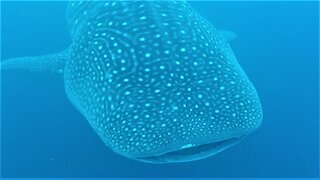 0:42
0:42
WildCreatures
4 years ago $31.69 earnedMassive whale shark swims directly under surprised scuba diver
13.5K5 -
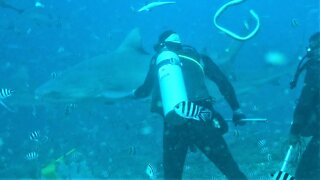 0:51
0:51
WildCreatures
1 year ago $16.09 earnedBrave scuba diver gives enormous bull shark a handshake
9.41K46 -
 0:32
0:32
WildCreatures
4 years ago $4.02 earnedFearless scuba diver fends off aggressive shark with her bare fist
41.2K2 -
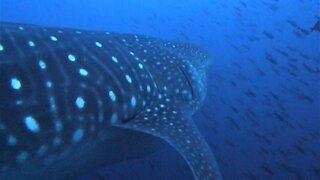 1:20
1:20
KristysWorld
2 years ago $60.12 earnedGigantic whale shark curiously inspects group of scuba divers in Galapagos
4.21K28